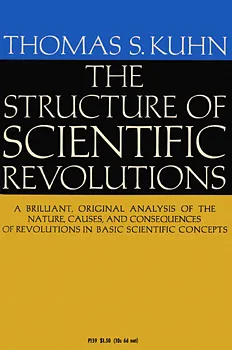What then is the nature of the more professional and esoteric research that a group’s reception of a single paradigm permits?
If the paradigm represents work that has been done once and for all, what further problems does it leave the united group to resolve?
Those questions will seem even more urgent if we now note one respect in which the terms used so far may be misleading.
In its established usage, a paradigm is an accepted model or pattern, and that aspect of its meaning has enabled me, lacking a better word, to appropriate ‘paradigm’ here. But it will shortly be clear that the sense of ‘model’ and ‘pattern’ that permits the appropriation is not quite the one usual in defining ‘paradigm.’
In grammar, for example, ‘amo, amas, amat’ is a paradigm because it displays the pattern to be used in conjugating a large number of other Latin verbs, e.g., in producing ‘laudo, laudas, laudat.’
In this standard application, the paradigm functions by permitting the replication of examples any one of which could in principle serve to replace it. In a science, on the other hand, a paradigm is rarely an object for replication.
Instead, like an accepted judicial decision in the common law, it is an object for further articulation and specification under new or more stringent conditions.
To see how this can be so, we must recognize how very limited in both scope and precision a paradigm can be at the time of its first appearance. Paradigms gain their status because they are more successful than their competitors in solving a few problems that the group of practitioners has come to recognise as acute.
To be more successful is not, however, to be either completely successful with a single problem or notably successful with any large number. The success of a paradigm—whether Aristotle’s analysis of motion, Ptolemy’s computations of planetary position, Lavoisier’s application of the balance, or Maxwell’s mathematisation of the electromagnetic field—is at the start largely a promise of success discoverable in selected and still incomplete examples.
Normal science consists in the actualisation of that promise, an actualisation achieved by extending the knowledge of those facts that the paradigm displays as particularly revealing, by increasing the extent of the match between those facts and the paradigm’s predictions, and by further articulation of the paradigm itself.
Few people who are not actually practitioners of a mature science realise how much mop-up work of this sort a paradigm leaves to be done or quite how fascinating such work can prove in the execution. And these points need to be understood. Mopping-up operations are what engage most scientists throughout their careers.
They constitute what I am here calling normal science. Closely examined, whether historically or in the contemporary laboratory, that enterprise seems an attempt to force nature into the preformed and relatively inflexible box that the paradigm supplies.
No part of the aim of normal science is to call forth new sorts of phenomena; indeed those that will not fit the box are often not seen at all.
Nor do scientists normally aim to invent new theories, and they are often intolerant of those invented by others.1 Instead, normal-scientific research is directed to the articulation of those phenomena and theories that the paradigm already supplies.
Perhaps these are defects. The areas investigated by normal science are, of course, minuscule; the enterprise now under discussion has drastically restricted vision.
But those restrictions, born from confidence in a paradigm, turn out to be essential to the development of science. By focusing attention upon a small range of relatively esoteric problems, the paradigm forces scientists to investigate some part of nature in a detail and depth that would otherwise be unimaginable.
And normal science possesses a built-in mechanism that ensures the relaxation of the restrictions that bound research whenever the paradigm from which they derive ceases to function effectively. At that point scientists begin to behave differently, and the nature of their research problems changes.
In the interim, however, during the period when the paradigm is successful, the profession will have solved problems that its members could scarcely have imagined and would never have undertaken without commitment to the paradigm. And at least part of that achievement always proves to be permanent.
To display more clearly what is meant by normal or paradigm-based research, let me now attempt to classify and illustrate the problems of which normal science principally consists.
For convenience I postpone theoretical activity and begin with fact-gathering, that is, with the experiments and observations described in the technical journals through which scientists inform their professional colleagues of the results of their continuing research.
On what aspects of nature do scientists ordinarily report? What determines their choice? And, since most scientific observation consumes much time, equipment, and money, what motivates the scientist to pursue that choice to a conclusion?
Excerpt From: Kuhn, Thomas S. “The Structure of Scientific Revolutions.”
Disclaimer: The views and opinions expressed in this article are the personal opinions of the author.
The facts, analysis, assumptions and perspective appearing in the article do not reflect the views of GK.







